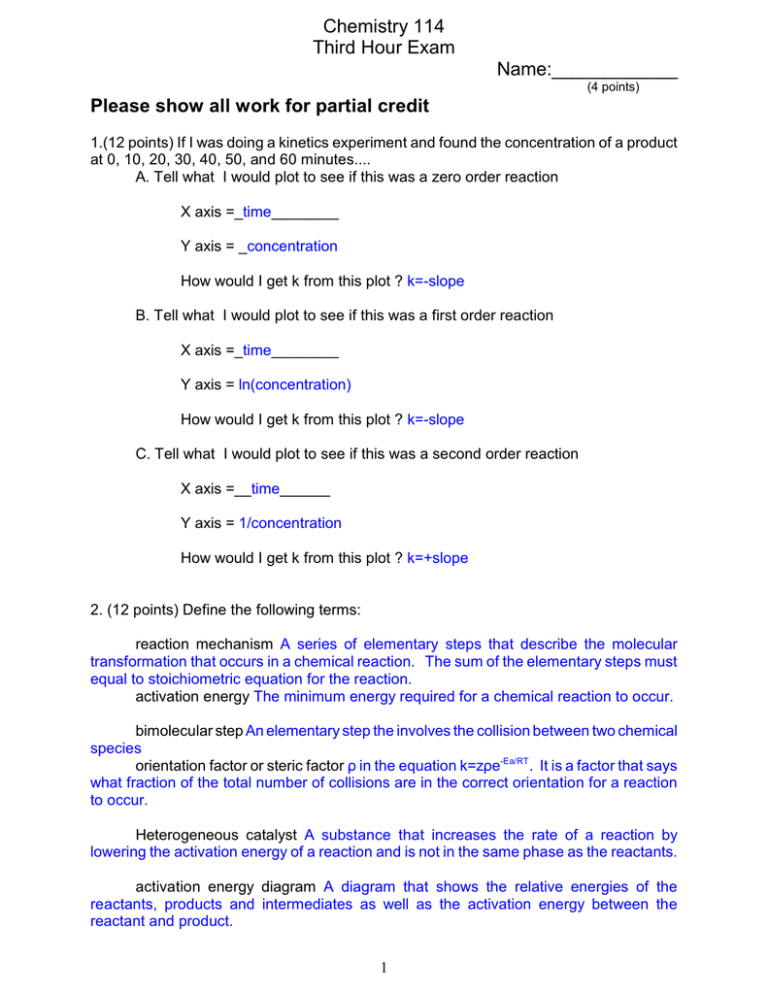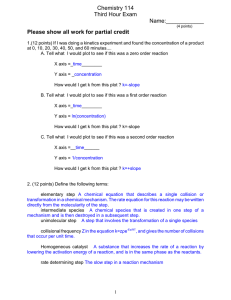Chemistry 114 Third Hour Exam Name:____________ Please show all work for partial credit
advertisement

Chemistry 114 Third Hour Exam Name:____________ (4 points) Please show all work for partial credit 1.(12 points) If I was doing a kinetics experiment and found the concentration of a product at 0, 10, 20, 30, 40, 50, and 60 minutes.... A. Tell what I would plot to see if this was a zero order reaction X axis =_time________ Y axis = _concentration How would I get k from this plot ? k=-slope B. Tell what I would plot to see if this was a first order reaction X axis =_time________ Y axis = ln(concentration) How would I get k from this plot ? k=-slope C. Tell what I would plot to see if this was a second order reaction X axis =__time______ Y axis = 1/concentration How would I get k from this plot ? k=+slope 2. (12 points) Define the following terms: reaction mechanism A series of elementary steps that describe the molecular transformation that occurs in a chemical reaction. The sum of the elementary steps must equal to stoichiometric equation for the reaction. activation energy The minimum energy required for a chemical reaction to occur. bimolecular step An elementary step the involves the collision between two chemical species orientation factor or steric factor ñ in the equation k=zñe-Ea/RT . It is a factor that says what fraction of the total number of collisions are in the correct orientation for a reaction to occur. Heterogeneous catalyst A substance that increases the rate of a reaction by lowering the activation energy of a reaction and is not in the same phase as the reactants. activation energy diagram A diagram that shows the relative energies of the reactants, products and intermediates as well as the activation energy between the reactant and product. 1 3. (12 POINTS) If it takes 4 hours to cook a turkey at 325oF (163oC) and 12 hours to cook the same turkey at 225o (107oC), what is the activation energy for cooking a turkey? Hint: the rate of the reaction, k=1/cooking time. 163oC = 163 + 273 = 436K k at this temp ~ 1/4 = .25 hr-1 107oC= 107 + 273 = 380K k at this temp ~1/12 = .083 hr-1 You can also express the rate in 1/minutes 4. The following 6 mechanisms have been proposed for a reaction with the stoichiometry of A6B +C I II Step 1. A62B Slow Step 1. A6D Fast Equilibrium Step 2. B6C Fast Step 2. D6B+C Slow Sum=A6B+C Sum=A6B+C III IV Step 1. A6B+D Fast Equilibrium Step 1. A+B6D Slow Step 2. D6C Slow Step 2. D6C Fast Sum=A6B+C Sum= A+B6C V VI Step 1. A+A6B+C Slow Step 1. A+A6B+D Slow Step 2. D6C Fast Sum=A+A6B+C Sum=A+A6B+C Can any of the above mechanisms be eliminated?, if so, which one(s) IV,V,VI__ What would be the experimental rate law corresponding to mechanism ?rate=k[A] What would be the experimental rate law corresponding to mechanism II?rate=k1k2/k-1 [A] What would be the experimental rate law corresponding to mechanism III? rate =k1k2/k-1[A]/[B] What would be the experimental rate law corresponding to mechanism IV?rate =k[A][B] What would be the experimental rate law corresponding to mechanism V? rate=k[A]2 What would be the experimental rate law corresponding to mechanism VI?rate=k[A]2 2 5 A (4 points).Make a reaction energy diagram for a reaction with a mechanism of A6B if A has an energy of 15 kJ, B has an energy of 10 kJ, and the reaction has an activation of 15 kJ. Hard to make this picture on my word processor. But the reactant starts at 15 kJ, then there is a hump up to 30 kJ, and then the curve slopes down to the product at 10 kJ B (4 points). Make a reaction energy diagram for a reaction with a mechanism of A6B if A has an energy of 5 kJ, B has an energy of 10 kJ, and the reaction has an activation of 15 kJ. Starts at 5 kJ, humps up to 20 kJ, then slopes down to 10 kJ C (4 points). Make a reaction energy diagram for the two step reaction mechanism: Step 1: A6B Fast Step 2: B6C Slow In which the energy of A is 5 kJ, B is 10 kJ and C is -10 kJ. Make your own activation energies that are consistent with this mechanism. This was a little more advanced. Starts at 5 kJ, has an activation hump the comes to a line at 10 kJ, then a second activation hump before it gets to the final product at -10 kJ. Since step 2 of the reaction was the slow step the distance between the A and the first activation hump had to be lower than the hump between B and the second activation hump 6 A(6 points). Write the equilibrium expressions that correspond to these reactions: CO(g) + NO2(g) W CO2(g) + NO(g) K=[CO2][NO]/[CO][NO2] CaCO3(s) W CaO(s) + CO2(g) K=[CO2] (Solids don’t appear in equilibrium expressions) B (6 points).Write the chemical reactions that correspond to these equilibrium expressions: ___2N2(g) + 6H2(g) 64NH3(g) NH3(aq) + H2O(l)6NH4+(aq) + OH-(aq) When you first write the equation you should see that it is not balanced, and figure out that you need to add a water 3 7. (12 points) PCl5(g) W PCl3(g) + Cl2(g) has KC of .0520 M at 25oC Calculate the KC for the reactions: PCl3(g) + Cl2(g) W PCl5(g) Reverse of original equation so Knew =1/Kold =1/.052M = 19.23 M-1 3Cl2(g) + 3PCl3(g) W3PCl5(g) 3 x the above equation so Knew =Kold3 =19.233 = 7,112 M-3 Calculate the KP for the reaction 2PCl5(g) W 2PCl3(g) + 2Cl2(g) This involves both 2X the original equation and the conversion from KC to Kp Start with squaring the original equation K=.05202 = .002704 Now KP = KC(RT)Än, Än=(2+2)-2 =2 KP = .002704(.08206A298)2 =1.62 atm2 8. At a certain temperature 0.800 mole of SO3 is placed in a 2.00-L container and the reaction 2SO3(g) W 2SO2(g) + O2(g) comes to equilibrium. If .100 mole of O2 is present in the container at equilibrium, calculate KC. I will do my ice table in moles and convert to molarity before I calculate Kc, You can also convert to molarity first, and then not worry about it later. I C E 2SO3(g) W 2SO2(g) .8 0 -2X +2X .8-2X 2X X must be equal to .11 So E .8-.2 .20 E .6 .20 + O2(g) 0 +X .10 = 0+X .10 .10 converting to molarity since in a 2 L container E .3 .10 .05 K= (.10)2(.05)/.32 =.00556M 4



